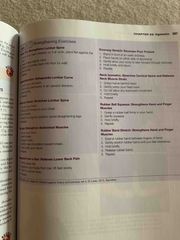![]()
![]()
![]()
Use LEFT and RIGHT arrow keys to navigate between flashcards;
Use UP and DOWN arrow keys to flip the card;
H to show hint;
A reads text to speech;
22 Cards in this Set
- Front
- Back
|
Carpal tunnel syndrome |
Pain associated with continued flex and extension of the wrist |
|
|
Cumulative trauma disorders |
Painful conditions that result from ongoing stresses to muscles, tendons, nerves, and joints |
|
|
Ergonomics |
Adaption of work environment and tasks to the human body |
|
|
Maximum horizontal reach |
Reach created when the upper arm is fully extended |
|
|
Maximum vertical each |
Created by a vertical sweep of the forearm while the elbow is kept at mid torso |
|
|
Musculoskeletal disorders |
Painful conditions that affect both muscle and bones such as neck or back pain and carpet tunnel syndrome |
|
|
Neutral position |
Position when body is properly aligned and the distribution of weight throughout the spine is equal |
|
|
Normal horizontal reach |
Created by a sweet of the forearm with the upper arm held by the side |
|
|
Sprains |
Injuries caused by sudden twisting or wrenching of a joint with stretching or tearing joints |
|
|
Strains |
Injuries caused by extreme stretching of muscles+ligaments |
|
|
Thenar eminence |
Flesh mound on the palm at the base of the thumb |
|
|
Ergonomics in the dental office |
Ergonomics designs the work area and the task around the human body. Members of the dental team most frequently perform in a seated position and they often use excessive motion and have unbalanced posture. Many dental team members experience MSDS (musculoskeletal disorders) Early on shot of pain should alert to the work that 1. Imbalance exists 2. If it is ignored serious damage can occur over time. |
|
|
Ergonomics chair side tips |
Use muscles to remain balanced for ease of movement Avoid prolonged awkward positions Do not remain in one position for an extended time Do not constantly lean forward or to the side Take breaks Remain in good physical condition Avoid repetitive movements Rearrange items in the operatory for easy use |
|
|
Dental assistant positioning |
Sit at patients shoulders Knees even with the edge of the patients headrest Head in up right position Back straight and supported with back rest Thighs parallel to the floor Elbows kept close to your body Avoid sitting on the edge of your chair Keep your eye level about 6 inch above the dentist |
|
|
Posture |
Affected the ability of RDA to reach, hold, and use equipment. Positioning also influences how long RDA can preform without suffer from effects |
|
|
Operator positioning |
Head in an upright position Elbows kept close Thighs parallel to the floor Work in neutral position Reposition patient as necessary |
|
|
Neutral position |
Ideal way to work. Sitting up right with your weight evenly distributed. Legs should be separated with your feet flat on the floor or footrest when you are working |
|
|
Reaching movements |
Keep most/everything you need at a comfortable distance ( not above shoulder level or below the waist) make sure they are in normal horizontal reach Keep the light at a safe maximum vertical reach Other supplies should be placed within maximum horizontal reach |
|
|
Repetition and force |
Increase the risk for cumulative disorders. To prevent this take breaks, alternate difficult procedures with less stressful ones. |
|
|
Gloves |
Can place excessive tensions on the thenar eminence |
|
|
Muscle strength if exercises |
frequently rest hands Rest eyes by focusing eyes at a distance for 20 seconds To relive back neck and shoulder pain do a a full back release Shoulder shrugging |
|
|
Strengthen exercises |

Back (Definition) |

